Full disclaimer: my team and I created the first draft of this content using ChatGPT - aptly so.
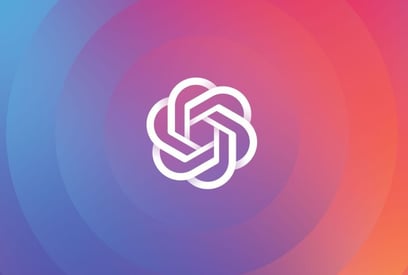
Image credits: OpenAI
AI has been the tech buzzword for far too long. Many tech aficionados and forward thinking companies have been looking into implementing AI for their business for the past 10 years or more.
With the public launch of ChatGPT in November 2022, we see the application of AI come to live in a myriad of new forms.
Its meteoric rise brought about awe, fear, optimism, and application of AI like never before. On one hand, ChatGPT is AI. On the other hand, it is so much more.
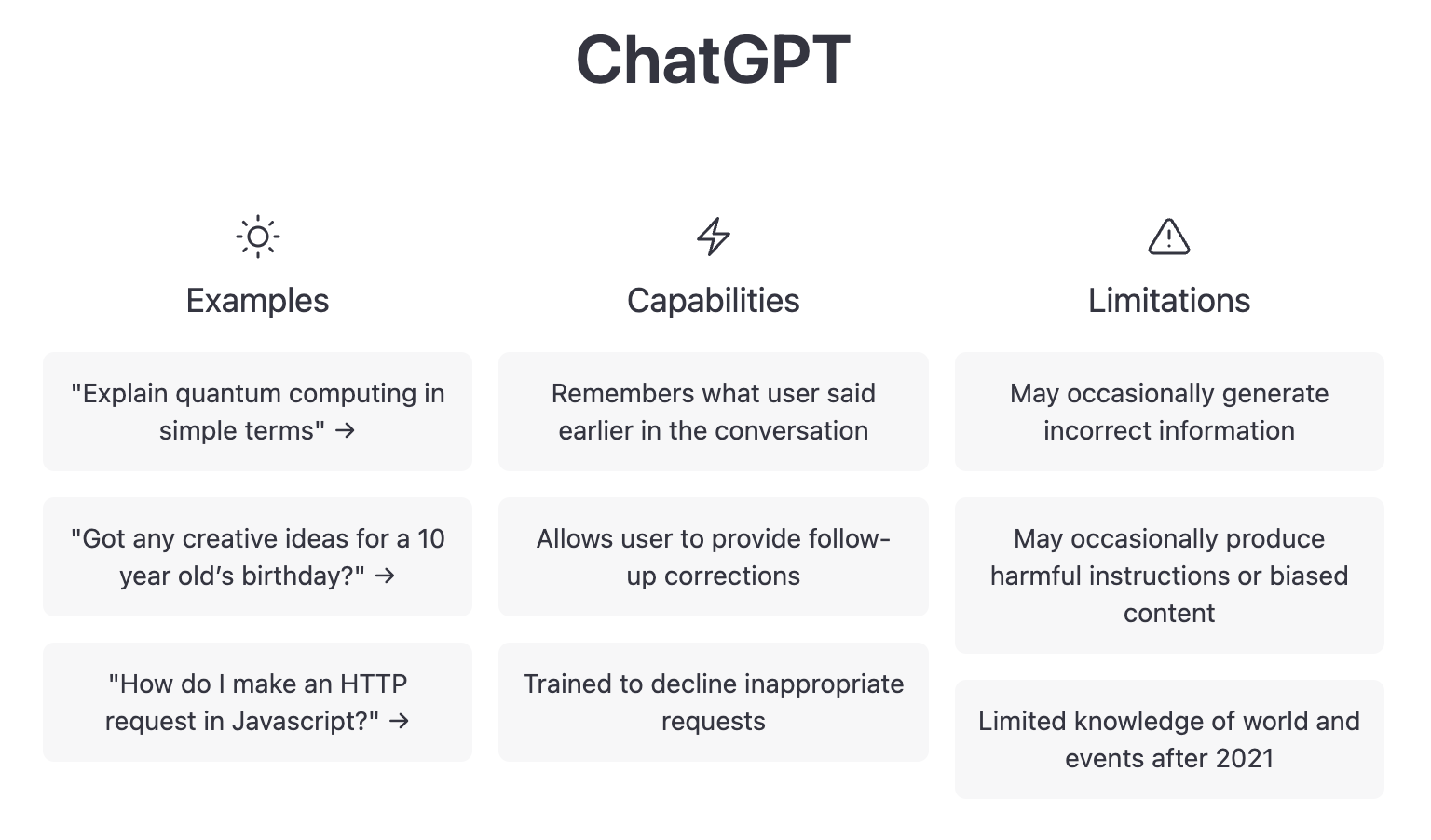
AI tech continued to improve and became more sophisticated over time. it began to be used in more complex areas such as customer service, sales and marketing, and supply chain management.
Now that ChatGPT is in the picture, we’re seeing dozens (or hundreds) more iterations of AI utilization for businesses and teams all over the world.
Many marketers, businesses, and productivity enthusiasts have shared their recommendations on how to best utilize ChatGPT to improve team and personal outputs.
In this article, I’d like to dive deeper into the evolving AI and ChatGPT application in a field that’s especially close to my heart: managing people and leadership.
This is the excerpt that came from ChatGPT when I asked it to explain itself:
“ChatGPT is a language model developed by OpenAI, a leading AI research lab.The model was first introduced in 2019 and is based on the GPT (Generative Pre-trained Transformer) architecture.
ChatGPT is designed to generate human-like text and can be trained on a large corpus of text data to perform a variety of language tasks, such as question-answering, machine translation, and text summarization.
The development of ChatGPT and other large language models has been a major breakthrough in the field of AI and natural language processing.
Since its introduction, ChatGPT has continued to evolve and improve, and OpenAI has released multiple versions of the model with increasing capacity and accuracy. Today, ChatGPT is considered one of the most advanced AI language models and is widely used by businesses and organizations for a variety of applications.”
Nothing new here. ChatGPT has become so popular that most people would’ve known about the above. If you’re keen to know how exactly ChatGPT was built, Louis Bouchard explained it well here.
But this is the part where not everyone is aware of:
• Question-answering
• Text generation based on a prompt
• Text completion
• Text summarization
• Conversational AI
• Analyzing sentiment(s) of a text
Although ChatGPT is already the most fluid, human-like language model to date, it still has some drawbacks.
It is due to these drawbacks that even highly-innovative companies need to deeply consider ChatGPT’s implementation in their processes.
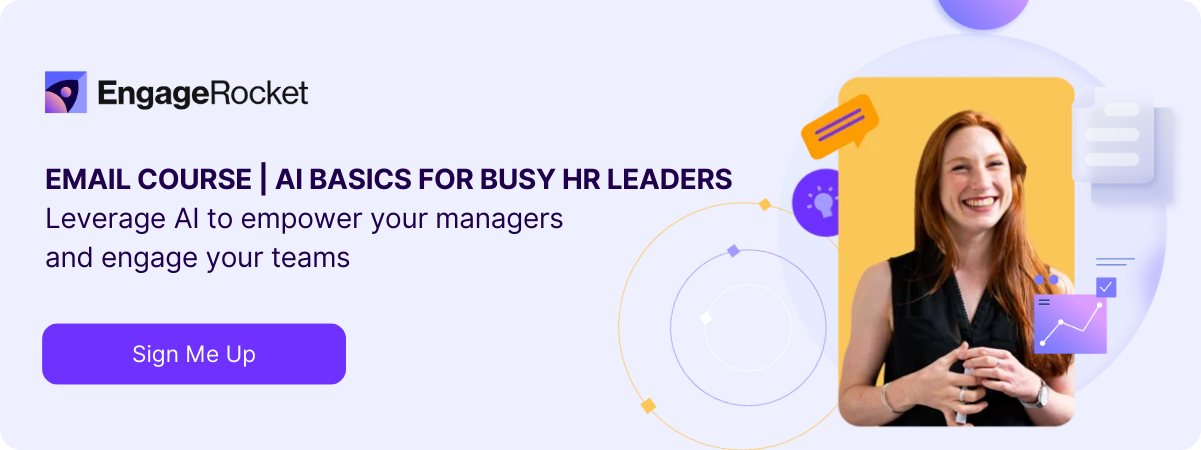
ChatGPT has been trained on a large corpus of text data that humans have been generating across time, which means that they will include all the human biases that exist, including gender and racial biases.
This may result in biased outputs and even perpetuate harmful stereotypes, such as this one that’s been widely shared:
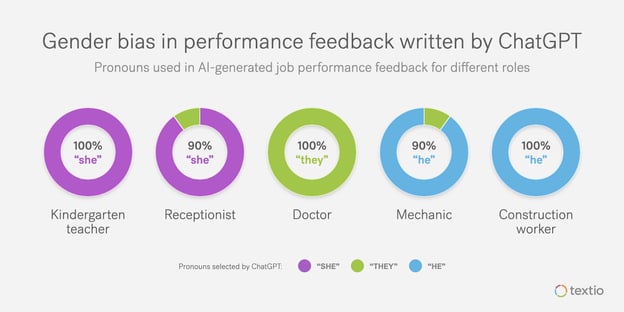
ChatGPT lacks a deep understanding of the world and common sense knowledge. This can result in incorrect or nonsensical answers to certain questions, especially those that require a deeper understanding of context or real-world situations.
It can range across questions from everyday life like the best way to make a sandwich (which can differ widely based on personal preferences) to questions on complex topics such as the best way to eradicate poverty (which can depend on the sociopolitical context of each country/region).
While ChatGPT is capable of generating novel text by combining different sources of information it is trained on through combinational creativity, it is still limited by the data it has been trained on. This means it can struggle to generate truly creative text that is transformational, and often produces output that is repetitive or formulaic.
*** It should be noted that you can actually determine how repetitive you want the output to be if you use GPT(through adjusting its temperature) instead of ChatGPT in their current versions.
Since ChatGPT is trained to generate human-like text based on a large number of information sources, it means there is a risk of unintended consequences, such as the spread of misinformation or malicious content.
The computational resources required to train and run large AI models like GPT are substantial, and this can result in high costs for organizations and individuals who want to use its capabilities.
Integrating ChatGPT into real-world applications can also pose technical challenges, such as the need for data privacy, data security, and compatibility with existing systems.

I want to first highlight the following for consistency’s sake: ChatGPT is NOT the same as GPT-3.
Here’s how ChatGPT explains it:
“ChatGPT is a type of artificial intelligence (AI) that is designed to generate conversations. It uses natural language processing (NLP) to understand what people say and then generate responses that sound like they were written by a human. GPT-3 is a more advanced AI system that can generate text, code, and complete tasks. It is more powerful than ChatGPT and can generate more complex conversations and tasks.”
In human language, ChatGPT is a scaled-down version of GPT-3 that is trained on conversational data and hence responds more effectively to human input/questions. So essentially, ChatGPT acts more like a chatbot than GPT3.
If we look at the full spectrum of human resources and people management, there are so many areas that could be made even better with the aid of ChatGPT.
As AI leader Allie K. Miller rightly pointed out:
Let’s explore the different use cases by roles and functions:
Managers with multiple direct reports can make use of ChatGPT to retrieve appropriate information about the direct reports’ performance. ChatGPT can also provide mangers with insights and recommendations on how to improve direct reports’ performance.
To facilitate performance review and appraisal processes, ChatGPT can be programmed to help ensure all the paperwork is done appropriately and coordinate between multiple stakeholders.
This is an example of what ChatGPT generated when our People Scientist prompted it for a performance review use case:
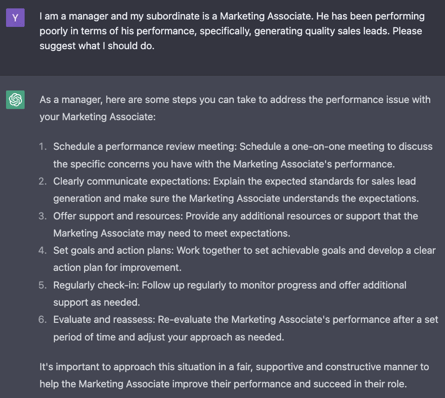
Source: ChatGPT
Pretty good, we'd say!
To facilitate performance review and appraisal processes, ChatGPT can be programmed to help ensure all the paperwork is done appropriately and coordinated between multiple stakeholders.
Feedback for employees can be gathered for engagement, development, and performance management purposes - killing three birds with one stone.
ChatGPT can foster a feedback-giving culture in organizations by prompting employees to give feedback to others in a timely manner and summarizing disparate pieces of feedback in a meaningful way.
For example, this is the latest tool we've been working on at EngageRocket (please keep this top secret for now!)
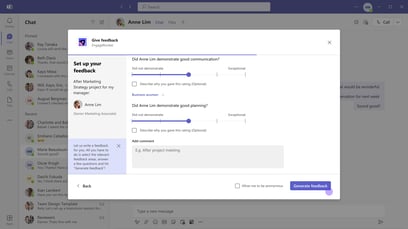
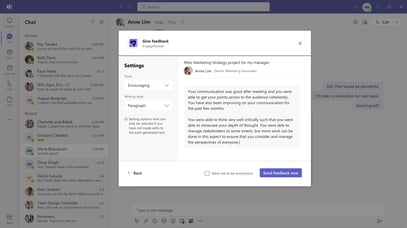
An illustrative feedback management tool by EngageRocket, powered by ChatGPT
The consolidation of feedback is also useful as input for managers to evaluate team members’ performance. This approach has value as feedback from multiple sources ensures fairness and greater accuracy.
When the feedback process is more efficient, managers can give feedback more regularly and that can engage and motivate employees to a greater extent.

Managers and leaders in an organization can make use of ChatGPT to acquire information that would be helpful to make decisions. For example, if a manager wants to understand which direct reports under him should be promoted, they can input the question into ChatGPT and ChatGPT can pull out the relevant information. However, this might require robust training of data to make effective decisions that are objective and unbiased.
ChatGPT can be used to facilitate collaboration and communication between team members.
For example, if team members have questions about a particular project, the chatbot can provide them with a link to the project resources - just like an internal FAQ.
This saves team members’ time for more valuable collaborative tasks like brainstorming, decision making, etc. A benefit to this will be enhanced knowledge and information sharing between employees.
Additionally, ChatGPT can be helpful in the area of project management. After project milestones have been set up, ChatGPT can be used to send reminders to team members on the milestones.
Coaching and mentoring someone requires a certain art - and with art, comes the need for brain power and empathy.
When coaching or mentoring employees, the coach or mentor first needs to understand the following about an employee - their characteristics, the projects they are taking on, their performance history, feedback they have received, among others.
It may be taxing for managers and leaders to consolidate all the information, especially if there are many direct reports. In such cases, ChatGPT can be used to consolidate the information and provide recommendations that will be helpful for coaching or mentoring purposes.
That being said, keep in mind that having a personalized approach is key for the effort to be fruitful. Avoid a ‘one-for-many’ approach when it comes to coaching and mentoring.
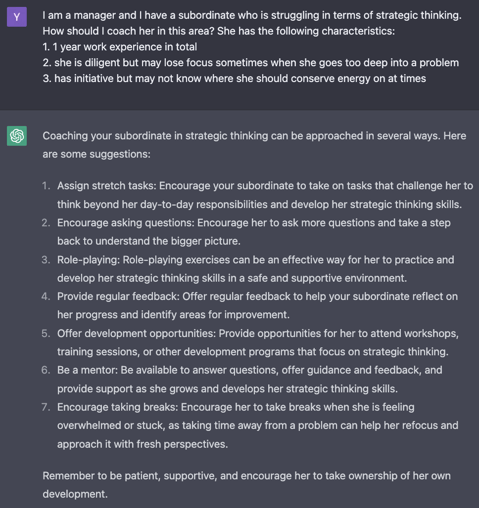 Source: ChatGPT
Source: ChatGPT
A good example is how ChatGPT can be used to automate the process of updating employee records.
Employees can go to the programmed chatbot if they wish to update their information such as contact details and external training records. This information can then be stored and updated in the organizational database.
This is especially critical considering as some (if not most) employees join for weeks or months after their last interview.
Before ChatGPT, there were already bots that facilitated real-time responses to employees’ questions (like the ones outlined here).
ChatGPT can now join this collection of tools to ensure a more seamless flow of information and knowledge between all stakeholders within an organization.
Lifecycle here refers to the 5 main stages that a typical employee goes through: Recruitment, Onboarding, Development, Engagement, and Exit.
ChatGPT can also be used to support employees and ensure that they are engaged and developed continuously throughout their entire tenure in the organization.
Here’s the breakdown of its potential utilization for each stage:
To be fair, there are many AI tools that have ventured into this area and they help HR be more effective in many ways. Some of the available AI tools include answering candidates about job opportunities and job application process, scheduling interviews, screening candidates based on some criteria determined by HR, etc (see the more comprehensive reviews here)
The aid of ChatGPT can help improve the candidate experience by answering them in a manner that is more fluid and human-like.
As previously suggested, ChatGPT can be used to provide automated responses to employee inquiries, such as details about the company, its various stakeholders, and policies. This article outlines great use cases of using a chatbot to improve the onboarding experience.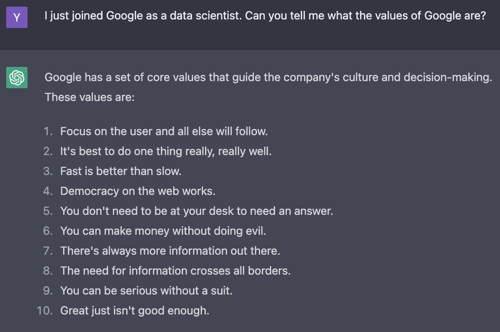
Source: ChatGPT
ChatGPT can be used to provide automated training and development courses, helping employees get up to speed with their roles quickly.
On top of that, employee onboarding may involve multiple stakeholders (e.g., HR, new hire, manager, IT, leaders) and ChatGPT can facilitate tasks and processes between these stakeholders so the ball doesn’t drop during a new hire’s onboarding.
One area that can be tremendously improved with the use of ChatGPT is in questionnaire design for performance feedback.
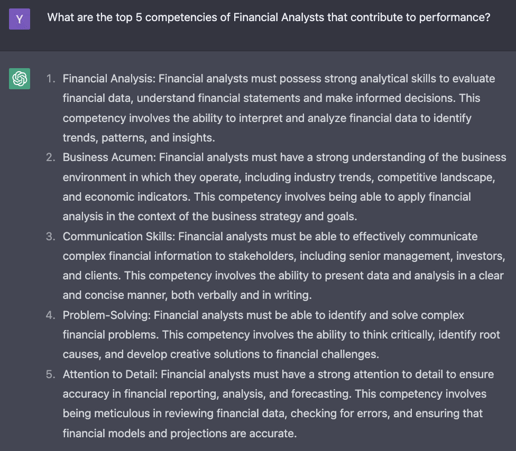
Source: ChatGPT
As an AI tool that uses natural language processing, it is no surprise that ChatGPT can also do a decent job in analyzing qualitative feedback from employees.
This helps employees and their managers better understand their strengths and areas of development. It can even help to suggest some competencies that would be relevant for specific job families, especially if the organization does not have an existing competency framework.
Organizations can also make use of ChatGPT to facilitate training and development more effectively. For example, the chatbot can ease HR’s work by responding to employees’ questions about the training and development courses and opportunities available.
Beyond just providing information, quizzes and assessments can be set up to test employees’ understanding of the course materials. Once developmental goals are set up, ChatGPT can be used to track and remind employees on their progress to ensure follow-through.

HR can use ChatGPT as a starting point to come up with ideas for questions in an engagement survey, but HR might need to adapt the questions to make them more actionable.
Here's an example:
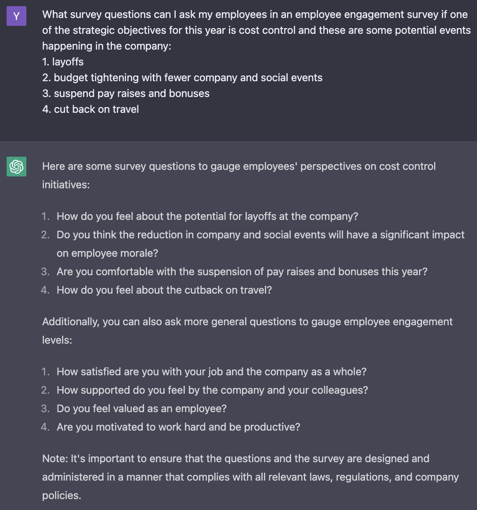 Source: ChatGPT
Source: ChatGPT
Another useful application is to draft communications to employees - to increase participation in the engagement survey and also to communicate the results to employees after.
Open-ended responses that employees provide in engagement surveys can also be effectively summarized using ChatGPT for more effective insights.
If managers, leaders and HR need some suggestions on what actions they can take to improve certain aspects of employee experience, they can also ask ChatGPT. It can be used to assign responsibilities across different stakeholders to take on actions to engage employees, and also send automated reminders to ensure ongoing effort.
Collecting data on what departing employees feel about their work, team and organization will be useful inputs to improve existing employees’ experience. ChatGPT can facilitate this data collection process via surveys.
When employees leave, effective offboarding will be crucial and ChatGPT can be used to automate some of these processes, such as ensuring that the necessary paperwork is done.
Before ChatGPT, there were already bots that facilitated real-time responses to employees’ questions (like the ones outlined here).
ChatGPT can now join this collection of tools to ensure a more seamless flow of information and knowledge between all stakeholders within an organization.
As Andreas Welsch, VP at SAP pointed out, there are 2 types of leaders when it comes to AI implementation: Those that need to be ambidextrous. And those that actually are.
So how can you, as a leader of an organization or a team, be the champion that elevates productivity through the use of ChatGPT (or any new tool for that matter)?
Here are some thoughtstarters:
The most common reason why organizations fail in introducing radical work changes is they just tell the employees that changes are coming.
Engaging employees and involving them in the process helps build employee ownership and gather more support from employees for the long term.
Here’s a thought:
Get employees to brainstorm on how the ChatGPT tool will be helpful for them at work. If employees’ ideas are selected and implemented, adoption is more likely to happen since they came up with the ideas themselves.
Another way to involve employees early is to create an ambassador program. Employees from different parts of the organization can be selected to be ambassadors based on their interests and contribution.
Other employees can approach the ambassadors if they have any challenges or questions related to the adoption of ChatGPT, and they will be more comfortable to do so especially if the ambassadors are within their business unit or direct team.
Look into the vast possibilities of ChatGPT by talking to subject matter experts or reading up on their work relating to the tool.
With the immense popularity of the tool, lots of developments may be popping up in a matter of months or even weeks. Just a few weeks ago, Microsoft already announced that they will be integrating GPT with their Microsoft Teams application to enhance the meeting experience.
Hence, organizations do not need to adopt ChatGPT themselves and instead leverage on existing or new tools that do the implementation leg-work for you, such as EngageRocket.

Before the organization is ready to implement ChatGPT into the workflow, managers and leaders should present the reasons why this change would be good for the employees and/or the organization.
A compelling vision with solid reasoning will motivate people to adopt the tool and form new habits around it.
Delivering this vision to employees in a timely and impactful manner will have tremendous benefits for the entire organization. Be sure to showcase how this change helps the organization (and employees) work toward certain goals - such as productivity, reduced workload, and others.
It will not be enough to just tell your employees “Use ChatGPT in your work” - employees may never do and you will never know.
We need to plan thoroughly with a realistic plan to extract all the gains possible from the tool and its adoption.
Here are some things organizations should include in their plan to ensure that people own the change and they are enabled throughout the process.
Barriers
What formal structures make it difficult for employees to adopt ChatGPT?
Is there any skills upgrading needed to adopt the tool?
Any personnel or information systems that need to be changed to use the tool?
Are managers bought in and ready to support the implementation of the new vision?
Key performance indicators
What is the current baseline for how things stand?
What is considered success in implementing ChatGPT (e.g., increased employee productivity)?
How will this success be measured?
What is the goal we want to achieve?
Project stakeholders and team
Project scope
Ensure that managers and leaders also use ChatGPT in their flow of work so that employees will model after the behaviors.
In many behavior-related areas, we consistently underestimate how much we are part of the problem, and this applies to role modeling change as well. The leaders of a company were asked if they “role model desired behavior changes,” and a full 86 percent report that they do.
When the same question is asked to people who report to these leaders, it received only a 53 percent positive response.
It goes to show that role modelling may not have been done well to achieve its intended purpose, and more can be done in this area.

CT Leong is the founder of EngageRocket. Before becoming an entrepreneur, he was a Regional Director of Gallup - one of the world's top HR advisories. He graduated with a degree in Economics at the University of Cambridge, and has an MA in Political Science from Columbia University.

Dr Yvonne Tan is the Lead People Scientist at EngageRocket. She has 10 years of experience in organizational psychology research and people analytics across APAC, ANZ, UAE and UK. In her free time, she likes to go museum hopping and cooking.
Follow Dr Yvonne Tan on LinkedIn here


Copyright © 2024 EngageRocket Pte Ltd. All rights reserved unless otherwise stated.